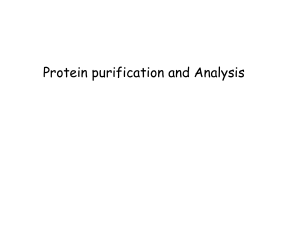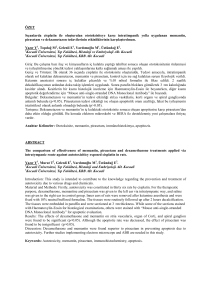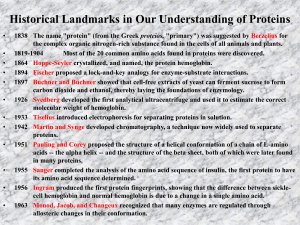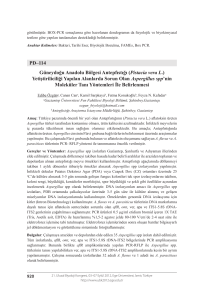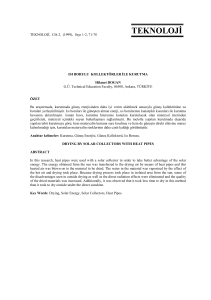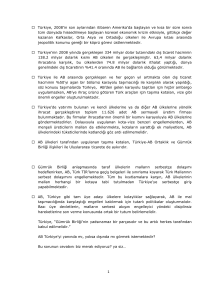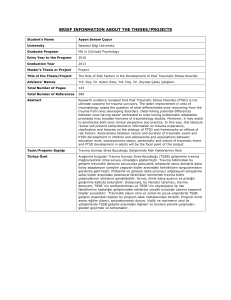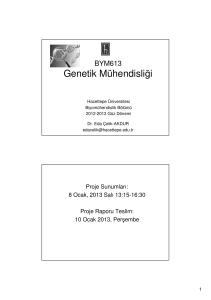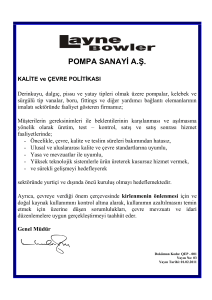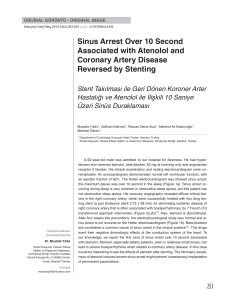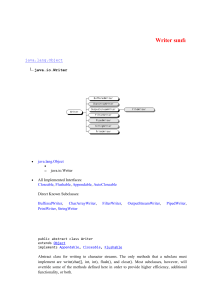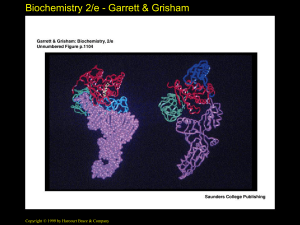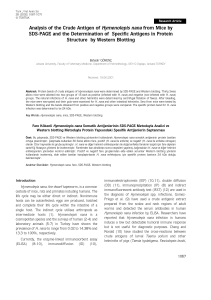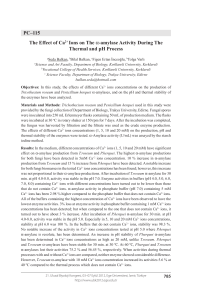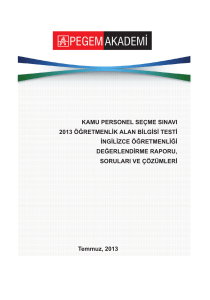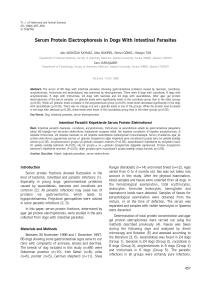2008-41A:2005_06
advertisement
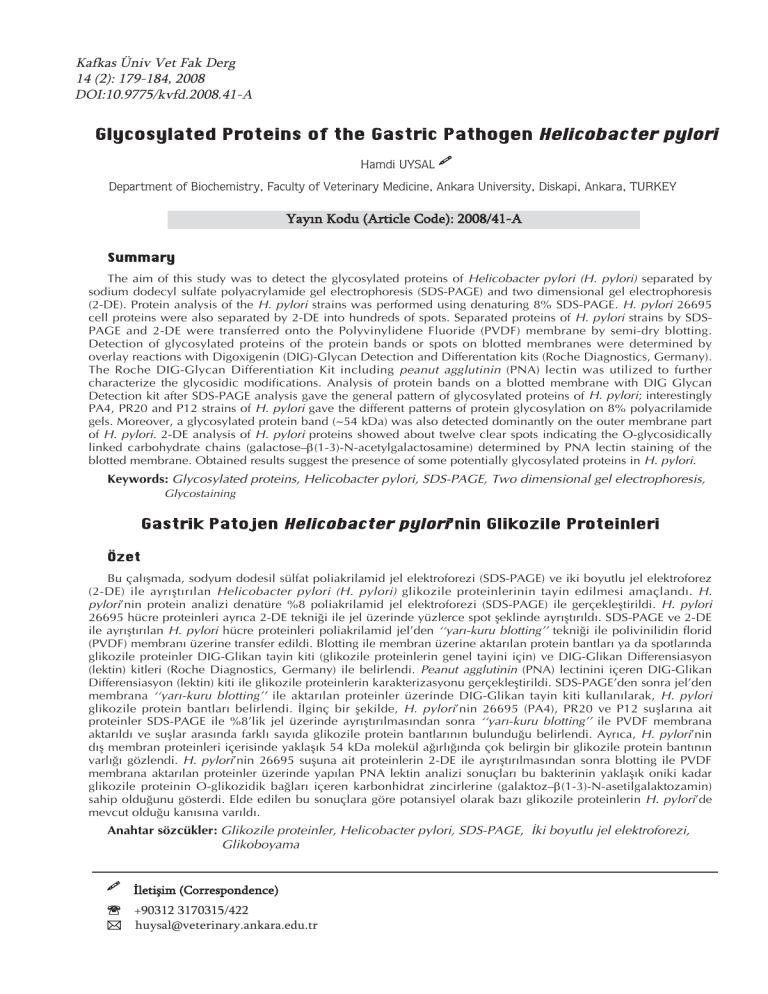
Kafkas Üniv Vet Fak Derg 14 (2): 179-184, 2008 DOI:10.9775/kvfd.2008.41-A Glycosylated Proteins of the Gastric Pathogen Helicobacter pylori Hamdi UYSAL Department of Biochemistry, Faculty of Veterinary Medicine, Ankara University, Diskapi, Ankara, TURKEY Yayın Kodu (Article Code): 2008/41-A Summary The aim of this study was to detect the glycosylated proteins of Helicobacter pylori (H. pylori) separated by sodium dodecyl sulfate polyacrylamide gel electrophoresis (SDS-PAGE) and two dimensional gel electrophoresis (2-DE). Protein analysis of the H. pylori strains was performed using denaturing 8% SDS-PAGE. H. pylori 26695 cell proteins were also separated by 2-DE into hundreds of spots. Separated proteins of H. pylori strains by SDSPAGE and 2-DE were transferred onto the Polyvinylidene Fluoride (PVDF) membrane by semi-dry blotting. Detection of glycosylated proteins of the protein bands or spots on blotted membranes were determined by overlay reactions with Digoxigenin (DIG)-Glycan Detection and Differentation kits (Roche Diagnostics, Germany). The Roche DIG-Glycan Differentiation Kit including peanut agglutinin (PNA) lectin was utilized to further characterize the glycosidic modifications. Analysis of protein bands on a blotted membrane with DIG Glycan Detection kit after SDS-PAGE analysis gave the general pattern of glycosylated proteins of H. pylori; interestingly PA4, PR20 and P12 strains of H. pylori gave the different patterns of protein glycosylation on 8% polyacrilamide gels. Moreover, a glycosylated protein band (~54 kDa) was also detected dominantly on the outer membrane part of H. pylori. 2-DE analysis of H. pylori proteins showed about twelve clear spots indicating the O-glycosidically linked carbohydrate chains (galactose–β(1-3)-N-acetylgalactosamine) determined by PNA lectin staining of the blotted membrane. Obtained results suggest the presence of some potentially glycosylated proteins in H. pylori. Keywords: Glycosylated proteins, Helicobacter pylori, SDS-PAGE, Two dimensional gel electrophoresis, Glycostaining Gastrik Patojen Helicobacter pylori’nin Glikozile Proteinleri Özet Bu çalşmada, sodyum dodesil sülfat poliakrilamid jel elektroforezi (SDS-PAGE) ve iki boyutlu jel elektroforez (2-DE) ile ayrştrlan Helicobacter pylori (H. pylori) glikozile proteinlerinin tayin edilmesi amaçland. H. pylori’nin protein analizi denatüre %8 poliakrilamid jel elektroforezi (SDS-PAGE) ile gerçekleştirildi. H. pylori 26695 hücre proteinleri ayrca 2-DE tekniği ile jel üzerinde yüzlerce spot şeklinde ayrştrld. SDS-PAGE ve 2-DE ile ayrştrlan H. pylori hücre proteinleri poliakrilamid jel’den ‘‘yar-kuru blotting’’ tekniği ile polivinilidin florid (PVDF) membran üzerine transfer edildi. Blotting ile membran üzerine aktarlan protein bantlar ya da spotlarnda glikozile proteinler DIG-Glikan tayin kiti (glikozile proteinlerin genel tayini için) ve DIG-Glikan Differensiasyon (lektin) kitleri (Roche Diagnostics, Germany) ile belirlendi. Peanut agglutinin (PNA) lectinini içeren DIG-Glikan Differensiasyon (lektin) kiti ile glikozile proteinlerin karakterizasyonu gerçekleştirildi. SDS-PAGE’den sonra jel’den membrana ‘‘yar-kuru blotting’’ ile aktarlan proteinler üzerinde DIG-Glikan tayin kiti kullanlarak, H. pylori glikozile protein bantlar belirlendi. İlginç bir şekilde, H. pylori’nin 26695 (PA4), PR20 ve P12 suşlarna ait proteinler SDS-PAGE ile %8’lik jel üzerinde ayrştrlmasndan sonra ‘‘yar-kuru blotting’’ ile PVDF membrana aktarld ve suşlar arasnda farkl sayda glikozile protein bantlarnn bulunduğu belirlendi. Ayrca, H. pylori’nin dş membran proteinleri içerisinde yaklaşk 54 kDa molekül ağrlğnda çok belirgin bir glikozile protein bantnn varlğ gözlendi. H. pylori’nin 26695 suşuna ait proteinlerin 2-DE ile ayrştrlmasndan sonra blotting ile PVDF membrana aktarlan proteinler üzerinde yaplan PNA lektin analizi sonuçlar bu bakterinin yaklaşk oniki kadar glikozile proteinin O-glikozidik bağlar içeren karbonhidrat zincirlerine (galaktoz–β(1-3)-N-asetilgalaktozamin) sahip olduğunu gösterdi. Elde edilen bu sonuçlara göre potansiyel olarak baz glikozile proteinlerin H. pylori’de mevcut olduğu kansna varld. Anahtar sözcükler: Glikozile proteinler, Helicobacter pylori, SDS-PAGE, İki boyutlu jel elektroforezi, Glikoboyama İletişim (Correspondence) ℡ +90312 3170315/422 [email protected] 180 Glycosylated Proteins of the Gastric... INTRODUCTION Glycosylation is a significant covalent modification of proteins 1,2. The past two decades have seen the perception change that glycosylation of proteins is restricted to eukaryotic organisms. Today we can assume from different observations that prokaryotic glycoconjugates may well be as common as glycoproteins in higher organisms or plant. For example, almost all archaeobacterial Slayers consist of glycoslated proteins 3,4. Another example is the great number of glycosylated exoenzymes of flagellar proteins. A major difference to eukaryotic glycoconjugates, however, is that the glycan structures of prokaryotic glycoproteins differ considerably. For example, there is no common structure such as the chitobiose core of eukaryotic N-glycans. Eubacterial S-layer glycans, for example, very often possess long linear or branched carbohydrate chains which can be linked via common N or O-glycosidic linkages. On the other hand, a few of them are O-linked via recentlydiscovered linkages from mannose or threonine have been found. In contrast, many of the archaeobacterial glycans are N-linked via asparagine . The main problem at the moment is the lack of sufficient coherent structural information to draw a picture of the general architecture of prokaryotic glycoproteins 5,6. Presently there is not much information available on the biological function of the glycan portion of bacterial proteins. In general, it is assumed that the glycans fulfill similar protective functions as have been suggested for eukaryotic glycoconjugates 7. One specific function, for example, is the determination of the cell shape by the glycan portion of halobacterial S-layer glycoproteins 8,9. Since only a few well-characterized prokaryotic glycoproteins are presently known many important questions about structure, biosynthesis, molecular biology and function of these glycoconjugates are still unanswered 5,6,10. The Gram negative bacterium H. pylori is one of the most common bacterial pathogens and causes a variet of diseases, such as gastritis, peptic ulcer or gastric cancer. In this study, glycobiologic and proteomic approach were chosen to detect glycosylated proteins of H. pylori. The aim of this study was to detect and demonstrate the potential glycosylated proteins of H. pylori separated by one (SDS-PAGE) and two dimensional gel electrophoresis (2-DE). MATERIAL and METHODS Whole experiments of this study were performed in the Central Biochemistry Unit of Max Planck Institute for Infection Biology in Berlin supported by a scholarship from Deutscher Akademischer Austauschdienst (DAAD, grant A/03/20329) in Germany. Helicobacter pylori cell culture and lysis H. pylori were grown on serum plates at 37°C under microaerobic conditions (5% O2, 85%N2 and 10% CO2) for two days 11. Bacteria were transferred into 50 ml cold PBS containing 1 tablet of complete protease inhibitors (Roche, Basle, CH). After centrifugation at 3.000 g and 4°C for 10 min and one wash step in 10 ml protease inhibitor containing PBS, the supernatant was omitted. The bacteria containing pellet was diluted with half a volume of distilled water and lysed by addition of urea, CHAPS, Servalyte pI 2-4 (Serva, Heidelberg, Germany) and DTT to obtain final concentrations of 9 M, 1.4%, 2% and 70 mM, respectively, For solubilitazion cells were shaken for 30 min at room temperature and insoluble components were separated by centrifugation at 100.000 g for 30 min. The supernatants were stored in aliquots at -70°C. Two-dimensional electrophoresis H. pylori cell proteins were separated by twodimensional electrophoresis according to the methods as previously described 12,14,15. For semidry blotting and Coomassie dyed gels 50 μg of protein were applied to the gels. The gel was stained with Coomassie Brilliant Blue G-250 as described 16. Sodium dodecyl sulfate polyacrylamide gel electrophoresis (SDS-PAGE) and Semi-Dry Blotting For the analysis of H. pylori samples by SDSPAGE 50 μg of protein were loaded on the gels. Protein analysis of the H. pylori strains was performed using denaturing 8% SDS-PAGE according to the method of Laemmli 13. H. pylori cell samples and mixture of molecular weight (MW) markers were run on 8% gels by SDS-PAGE 181 UYSAL and blotted onto the PVDF membranes (Immobilon P, Milipore, Eschborn, Germany) using a semi-dry blotting system (Hoefer Large SemiPhor, Amersham Pharmacia Biotech AB, Sam Francisco, CA) 17. Detection of glycosylated proteins of Helicobacter pylori Glycosylated proteins of H. pylori strains were studies using Dig-Glycan Detection and Differentation Kits according to the manufacturers instructions (Roche Diagnostics, Germany). Electrophoretically, seperated proteins on gels were transferred onto the Polyvinylidene Fluoride (PVDF) membrane by semi-dry blotting and incubated with digoxigenin-labeled lectins (DIG glycan differentation kit, Roche Diagnostics Germany). The bound lectins were immunologically detected using an anti-digoxigenin Fab-fragment conjugated to alkaline phosphatase using the protocol supplied with the kit. DIG-glycan differentation kit contains five different DIG labelled lectins: PNA ( Peanut agglutinin; specific for the disaccharide galactosebeta(1-3)-N-acetylgalactosamine), GNA (Galanthus nivalis agglutinin; specific for terminal mannose residues), SNA (Sambucus nigra agglutinin; specific for terminal sialic acid alpha-2-6-linked to galactose), MAA (Maackia amurensis agglutinin; specific for sialic acid, alpha-2-3-linked to galactose), and DSA ( Datura stramonium agglutinin; specific for the disaccharide galactose-beta(1-4)-N-acetylneuraminic acid). DIG-Glycan detection kit (Roche Diagnostics, Germany) was also used for the glycostaining of Fig 1. Protein composition of whole-cell samples of H. pylori wild-type strain 26695. Intact bacterial cells were harvested from agar plates and the proteins were subjected to 2-DE analysis. Proteins were visualized by Coomassie Brillant Blue G-250 staining. Şekil 1. H. pylori 26695 suşu tüm hücre numunesinin protein kompozisyonu. Bakteri hücreleri kültürünün yapıldığı agar plate’ler üzerinden alınarak 2-DE ile protein analizine tabi tutuldu. Jel üzerindeki proteinler Coomassie mavisi (G-250) ile boyanarak gösterildi. blotted membranes for the general detection of glycosylated proteins according to the protocol supplied with the kit. RESULTS H. pylori cell proteins which were separated by two-dimansional electrophoresis into hundreds of spots with small gel technique. Whole-cell proteins of H. pylori 26695 were detected by Coomassie Brillant Blue G-250 staining of the gels (Figure 1). Separated proteins of H. pylori strains by SDSPAGE and/or 2D gel electrophoresis were transferred to PVDF membrane by semi-dry blotting technique. Detection of glycosylated proteins of the protein spots on blotted membranes were determined by overlay reactions with Digoxigenin (DIG) Glycan kit from Roche Diagnostics (Germany). The Roche DIG-Glycan Differentiation Kit (lectin protein detection) was also utilized to further characterize the glycosidic modifications. The kit contains five DIG labelled lectins: PNA lectin was obtained from the kit. It is specific for the disaccharide (galactose-beta(1-3)-N-acetylgalactosamine). The kit was used on semi-dry blotted protein samples according to the manufacturer’s protocol. Figure 2 and Figure 3 show the glycosylated protein spots of H. pylori 26695 cell analysed by 2-DE. Glycostaining was performed by PNA lectin staining of the blotted PVDF membrane (Figure 2). 182 Glycosylated Proteins of the Gastric... Fig 2. Glycosylated protein spots of H. pylori 26695 cell proteins analysed by 2DE. PNA lectin staining of H. pylori 26695 whole-cell proteins which was blotted onto PVDF membrane after separation by 2-DE. Şekil 2. İki boyutlu jel elektroforezi ile analiz edilen H. pylori 26695 hücre proteinlerine ait glikozile protein spotları. İki boyutlu jel elektroforezi ile analiz edilen H. pylori 26695 hücre proteinleri jel’den PVDF membrana blotting yöntemi ile aktarıldıktan sonra membran PNA lektini ile boyandı. Fig 3. Signed circles show the glycosylated protein spots of H. pylori cell. Glycosylated protein spots of H. pylori separated by 2-DE and blotted onto PVDF membrane were also stained with Coomassie Blue R250 after PNA lectin staining of PVDF membrane (see Fig 2). Şekil 3. H. pylori hücre proteinlerine ait glikozile protein spotları daire içinde gösterilmiştir. İki boyutlu jel elektroforezi ile analiz edilen H. pylori hücre proteinleri jel’den PVDF membrana blotting yöntemi ile aktarıldıktan sonra membran önce PNA lektini ile (Şekil 2’de görülen) daha sonra da Coomassie Blue R250 ile boyandı. 183 UYSAL Cell cultures of H. pylori were also performed according to the routine procedure in the laboratory. Protein analysis of the H. pylori strains 26695 (PA4, PR20 and P12) was performed using denaturing 8% SDS-polyacrylamide gels according to the method of Laemmli 13 (Figure 4). Fig 4. Glycosylated proteins of the H. pylori strains (26695 (PA4), PR20 and P12). Glycostaining of blotted PVDF membrane after the SDS-PAGE analysis of H. pylori strains was performed by DIG-Glycan detection kit. Applied samples to the 8% polyacrilamide gel: Lane 1; 26695 (PA4) strain of H. pylori, Lane 2; 26695 (PA4), strain of H. pylori membrane proteins, Lane 3; PR20 strain of H. pylori, Lane 4; P12 strain of H. pylori, Lane M; Mixture of standard protein markers with actual molecular weights. Şekil 4. SDS-PAGE ile analiz edilen H. pylori suşlarına 26695 (PA4, PR20 and P12) ait glikozile protein bantları. H. pylori suşlarının SDS-PAGE ile analizinden sonra proteinler jel’den PVDF membrana blotting yöntemi ile aktarıldıktan sonra membran DIG-Glikan tayin kiti ile glikoboyama yapıldı. %8’lik poliakrilamid gel’e uygulanan numuneler: 1 sıra; H. pylori PA4 suşu proteinleri, 2 sıra; H. pylori PA4 suşu membran proteinleri, 3 sıra; H. pylori PR20 suşu proteinleri, 4 sıra; H. pylori P12 suşu proteinleri, M sırası; protein molekül ağırlıklarını gösteren standard protein karışımı marker. DISCUSSION Today, it is clear that both N-glycosylation and O-glycosylation, once believed to be restricted to eukaryotes, also transpire in Bacteria and Archaea. Indeed, prokaryotic glycoproteins rely on a wider variety of monosaccharide constituents than do those of eukaryotes 18. Proteomics is the systematic study of the many and diverse properties in paralel manner, with the aim of providing detailed descriptions of the structure, function and control of biological systems in health and disease 19,20. In general, protein glycosylation in bacteria may have various possible applications in biotechnology, vaccine development, pharmaceutics and diagnostics 6. In this study, glycobiologic and proteomic methods were used to detect glycosylated proteins of H. pylori as they have not reported previously or well established so far as well as eukaryotic cells. As a proteomic approach, the two dimansional gel electrophoresis technique was used to analyse the protein composition of whole-cell samples of H. pylori strain 26695 (see Coomassie stained gel in Figure 1). Proteins could be identified by comparison with 2D PAGE database of the whole-cell lysate of strain 26695 (www.mpiib-berlin.mpg.de/2D-PAGE). The comparison yielded more than 200 protein species with apparent molecular weight and p I identical to those in the database for cellular proteins of H. pylori (strain 26695) 15. Structural characterisation of the carbohydrate chains of glycoproteins bound to Nitrocellulose or PVDF membrane, which have been separated on an two dimansional gel electrophoresis and transferred, showed that H. pylori proteins contain mainly O-glycosidically linked carbohydrate chains as determined by PNA lectin staining. Two dimansional electrophoretic analysis of H. pylori proteins showed about twelve clear spots indicating the O-glycosidically linked carbohydrate chains by PNA lectin staining of the blotted PVDF membrane (Figure 2 and Figure 3). Analysis of protein spots on membranes with DIG Glycan Detection kit after SDS-PAGE analysis gave the general pattern of glycosylated proteins of H. pylori; interestingly 26695 (PA4), PR20 and P12 strains of H. pylori gave different patterns of protein glycosylation on 8% polyacrylamide gels (Figure 4). It is interesting to note that a glycosylated protein band with a molecular weight of 54kDa (aproximately) was detected dominantly on the outer membrane part of H. pylori as seen in the 2nd lane in Figure 4. This glycosylated protein band on the membrane of H. pylori needs to be 184 Glycosylated Proteins of the Gastric... characterised in detail as it looks a diffusely glycosylated membrane protein. Moreover, MAA, GNA and DSA lectin stainings of the blotted membranes after two dimansional gel electrophoresis gave ten, six and four different glycosylated faint protein spots belong to 26695 strain of H. pylori respectively (data not shown). These results indicate that H. pylori 26695 strain proteins have different glycosylation patterns. In conclusion, above results of this preliminary work demonstrate that certain glycosylated proteins are present in H. pylori especially on the surface of this bacteria. These are interesting results that future studies should focus on to characterise and describe in more detail for the possible functions of these potentially glycosylated proteins of H. pylori in its pathogenicity as they have not been described before. Moreover, in general, future investigations on the bacterial Nglycosylation and O-glycosylation processes will advance glyco-engineering efforts as well as the development of new antibacterial agents. ACKNOWLEDGEMENTS This work was supported by Deutscher Akademischer Austauschdienst (DAAD, grant A/03/20329 from Germany) to study in the laboratory of Dr. Peter R. Jungblut in the Central Biochemistry Unit of Max Planck Institute for Infection Biology in Berlin, Germany. The author of the article is grateful to Dr. Peter R. Jungblut for his scientific support and invaluable help and to Ursula Zimny-Arndt and Ina Wagner for their excellent technical assistance during study in Max Planck Institute for Infection Biology in Berlin. REFERENCES 1. Lis H, Sharon N: Protein glycosylation: structural and functional aspects. Eur J Biochem, 218, 1-27, 1993. 2. Kornfeld R, Kornsfeld S: Assembly of Asparagine-Linked Oligosaccharides. Annu Rev Biochem, 54, 631-64, 1985. 3. Sleytr UB, Messner P, Pum D, Sara M: Crystalline Bacterial Cell Surface Proteins. Austin: R.G. Landes/Academic Pres, 1996. 4. Kandler O: Archaea (Archaebacteria). Progr Botany, 54: 1-24, 1993. 5. Messner P: Bacterial glycoproteins. Glycoconjugate Journal, 14 (1): 3-11, 1997. 6. Upreti RK, Kumar M, Shankar V: Bacterial glycoproteins: Functions, biosynthesis and applications. Proteomics, 3 (4): 363-379, 2003. 7. Montreuil J: Spatial conformation of glycans and glycoproteins. Biol Cell, 51,115-31, 1984. 8. Mescher MF, Strominger JL: Structural (shape-maintaining) role of the cell surface glycoprotein of Halobacterium salinarium. Proc Natl Acad Sci, USA 73 (8): 2687-2691, 1976. 9. Wieland F, Lechner J, Sumper M: The cell wall glycoprotein of halobacteria: Structural, functional and biosynthetic aspects. Zbl Bakt Hyg I Abt Orig, C3, 161170, 1982. 10. Benz I, Schmidt MA: Never say never again: Protein glycosylation in pathogenic bacteria. Molecular Microbiology, 45 (2): 267-276, 2002. 11. Odenbreit S, Wieland B, Haas R: Cloning and genetic characterization of Helicobacter pylori catalase and construction of a catalase-deficient mutant strain. J Bacteriol, 178, 6960–6967, 1996. 12. Jungblut PR, Seifert R: Analysis by high-resolution twodimensional electrophoresis of differentiation-dependent alterations in cytosolic protein pattern of HL-60 leukemic cells. J Biochem Biophys Meth, 21 (1): 47-58, 1990. 13. Laemmli UK: Claveage of the structural proteins during the assembly of the head of bacteriophage T4. Nature, 227, 680-685, 1970. 14. Klose J, Kobalz U: Two-dimensional electrophoresis of proteins: An updated protocol and implications for a functional analysis of the genome. Electrophoresis, 16, 1034-1059, 1995. 15. Jungblut PR, Bumann, D, Haas G., Zimny-Arndt U, Holland P, Lamer S, Siejak F, Aebischer A, Meyer TF: Comparative proteome analysis of Helicobacter pylori. Mol Microbiol, 36, 710-725, 2000. 16. Doherty NS, Littman BH, Reilly K, Swindell AC, Buss JM, Anderson NL: Analysis of changes in acute-phase plasma proteins in an acute inflammatory response and in rheumatoid arthritis using two-dimensional gel electrophoresis, Electrophoresis, 19, 355–363, 1998. 17. Jungblut P, Eckerskorn C, Lottspeich F, Klose J: Blotting efficiency investigated by using two-dimensional electrophoresis, hydrophobic membranes and proteins from different sources. Electrophoresis, 11 (7): 581-588, 1990. 18. Abu-Qarn M, Eichler J, Sharon N: Not just for Eukarya anymore: Protein glycosylation in Bacteria and Archaea. Curr Opin Struct Biol, 18 (5): 544-550, 2008. 19. Patterson SD, Aebersold RH: Proteomics: In the first decade and beyond. Nature Genet, 33, 311-323, 2003. 20. Jungblut PR, Holzhütter HG, Apweiler R, Schlüter H: The speciation of the proteome. Chem Cent J, 2,16, 2008.
